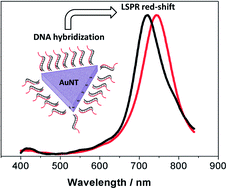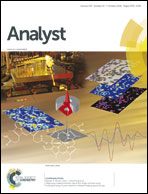Localized surface plasmon resonance (LSPR) biosensing using gold nanotriangles: detection of DNA hybridization events at room temperature†
Abstract
We present a proof-of-concept of the application of gold nanotriangles in sequence specific DNA detection, using localized surface plasmon resonance (LSPR) spectroscopy and dark-field optical microscopy. The sensing platform comprises gold nanotriangles immobilized on a glass chip and oligonucleotides as probes. Probe formation and testing complementary and non-complementary targets followed common chip technology protocols. Gold nanotriangles showed a remarkable sensitivity of 468 nm per RIU and allowed detection of 20-mer targets. When the target sequence was part of a 50-mer synthetic DNA oligonucleotide, LSPR shifts as high as 35 nm were observed. Conversely, when the target was present in PCR products of ca. 350 bp, obtained from clinical samples, LSPR shifts larger than 20 nm were observed. Moreover, LSPR shifts were less than ±1 nm for the respective non-complementary targets. These results with gold nanotriangles as sensors are a notable improvement to the LSPR shifts of less than 5 nm usually obtained for spherical gold nanoparticles of comparable sizes. Optimal conditions for the detection of synthetic and PCR product targets using gold nanotriangles and oligonucleotide probes were achieved with low percentages of intercalating thioalkanes; target hybridization at room temperature, 3 hours of incubation, and 2× SSC buffer stringency conditions.


 Please wait while we load your content...
Please wait while we load your content...